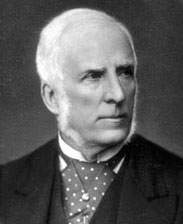John Callcott Horsley

John Callcott Horsley
Childhood and education
Horsley was born in
Family life

Horsley married Elvira Walter in 1846 with whom he had three sons: Edward (1848), Frank (1849), and Harry (1850). Elvira died of consumption in 1852 followed by the deaths of Edward and Harry in 1854 and Frank in 1857 due to scarlet fever.
Horsley remarried, to Rosamund Haden, who came from a family of distinguished surgeons—her father Charles Haden had a practice in Sloan Street and her brother
After his wedding to Rosamund in 1854 Horsley and his new wife toured the Midlands for five months to establish contacts with wealthy industrialists for portrait commissions. Horsley moved into 'Willesley', his house in Cranbrook in 1861, joining the Cranbrook Colony; while maintaining a home in London. The architect Richard Shaw adds "...tall chimneys and cosy 'inglenooks.'" in the Jacobean style to 'Willesley'.[2]
Career
Horsley's paintings were largely of historical subjects set in the seventeenth and eighteenth centuries, influenced by the
As a young artist Horsley was patronised by the collector John Sheepshanks, who bought two of Horsley's paintings: The Rival Performers (1839)[3] and Youth and Age (1839),[4] both of which are now part of the V&A collection.[2] Callcott Horsley exhibited a second painting entitled 'Youth and Age' at the Royal Academy in 1851.

In 1843 his cartoon (preliminary drawing) of "St Augustine Preaching" won a prize in the competition to provide interior decorations for
Horsley was rector and treasurer of the Royal Academy from 1875 to 1890 and 1882 to 1897 respectively. He earned the nickname 'Clothes-Horsley' for his opposition to the use of nude life models.
Protests against the nude in 1885 assumed a variety of forms: Moore's White Hydrangea was damaged by a 'scratching fiend' during the summer exhibition and life studies executed by Academy students were stolen. However, it was a letter printed in The Times on 20 May which proved the catalyst for igniting a national controversy around the exhibition of the nude. The letter was titled 'A Woman's Plea' and signed 'British Matron'. In fact it was penned by J. C. Horsley ...[10]
He resigned from the academy in 1897, and became a "retired Academician".

In 1843 Horsley designed the first ever Christmas card, commissioned by Henry Cole. It caused some controversy because it depicted a small child drinking wine. He also designed the Horsley envelope, a pre-paid envelope that was the precursor to the postage stamp.
In 1856 Horsley was photographed at "The Photographed Institute" by
Horsley was a member of the London-based Etching Club contributing illustrations to editions of "The Deserted Village" (Oliver Goldsmith) and "Songs of Shakespeare". He also illustrated a number of other books including "Little Princes" by Eliza Slater (London: Henry G. Bohn, 1890).
See also
Notes
- ^ a b c d One or more of the preceding sentences incorporates text from a publication now in the public domain: Chisholm, Hugh, ed. (1911). "Horsley, John Callcott". Encyclopædia Britannica. Vol. 13 (11th ed.). Cambridge University Press. p. 739.
- ^ a b c d e f The Cranbrook Colony: Fresh Perspectives, Wolverhampton Art Gallery, 2010
- ^ The Rival Performers (1839)
- ^ Youth and Age (1839)
- CourtauldInstitutes 17:1954, pp. 319–358.
- ^ Religion
- ^ "Satan touched by Ithuriel's Spear while whispering evil dreams to Eve"
- ^ John Callcott Horsley, R.A., Royal Academy of Arts Collections
- ^ See Lucinda Hawksley (2013) The Mystery of Princess Louise: Queen Victoria's Rebellious Daughter
- ISBN 9780719044038.
- doi:10.1093/ref:odnb/58919. (Subscription or UK public library membershiprequired.)
Further reading
- Horsley, J. C. Recollections of a Royal Academician (London: J. Murray, 1903).
External links
- 42 artworks by or after John Callcott Horsley at the Art UK site
- J C Horsley online (ArtCyclopedia)
- J C Horsley biography and paintings (thesussexweald.org)
- J C Horsley paintings (Art Renewal Center Museum)
- Works by J C Horsley (Royal Academy of Arts)
- Works by J C Horsley (V & A, London)
- Biography and Christmas card history
- Wedding rings (1883 painting)
- Showing a preference (1860 painting)
- The unwilling salute[permanent dead link] (Sotheby's)
- The Contrast: Youth and Age (1839 painting)
